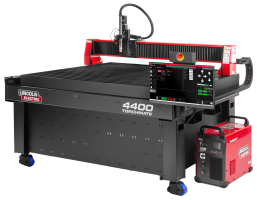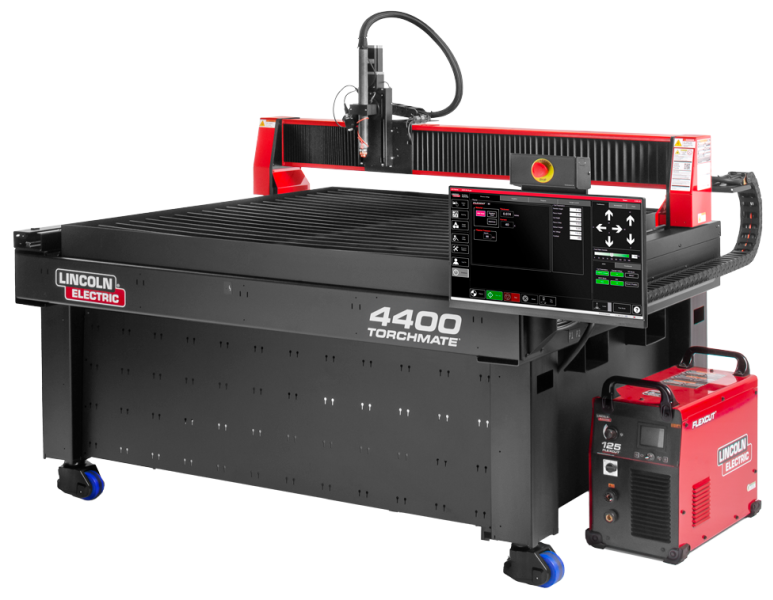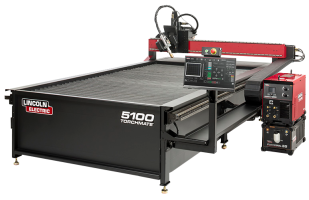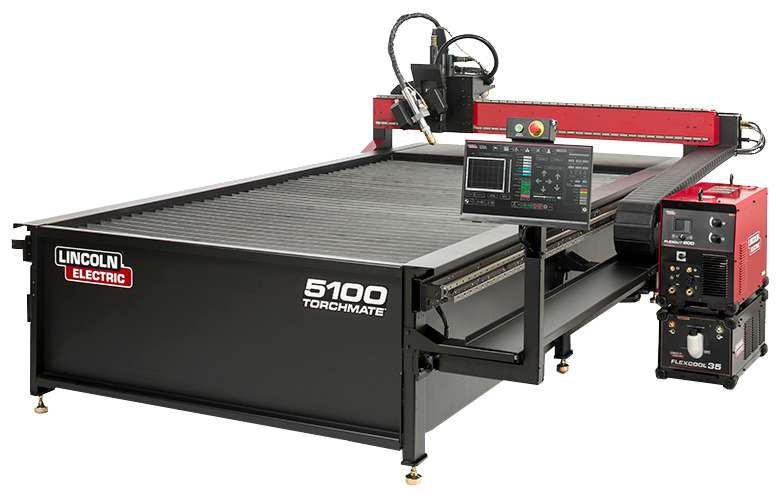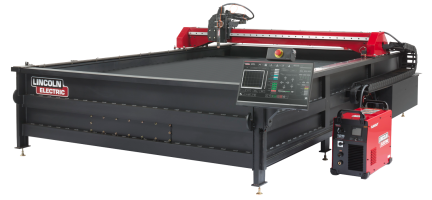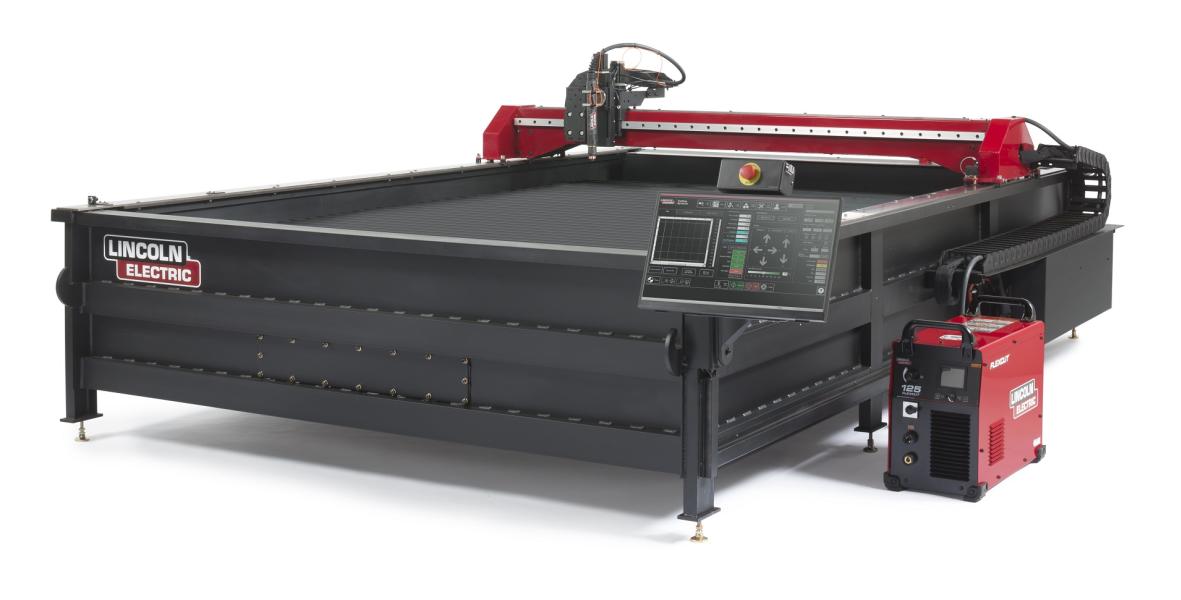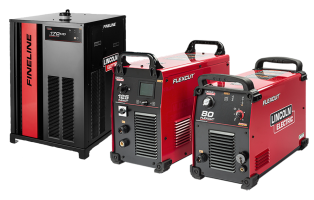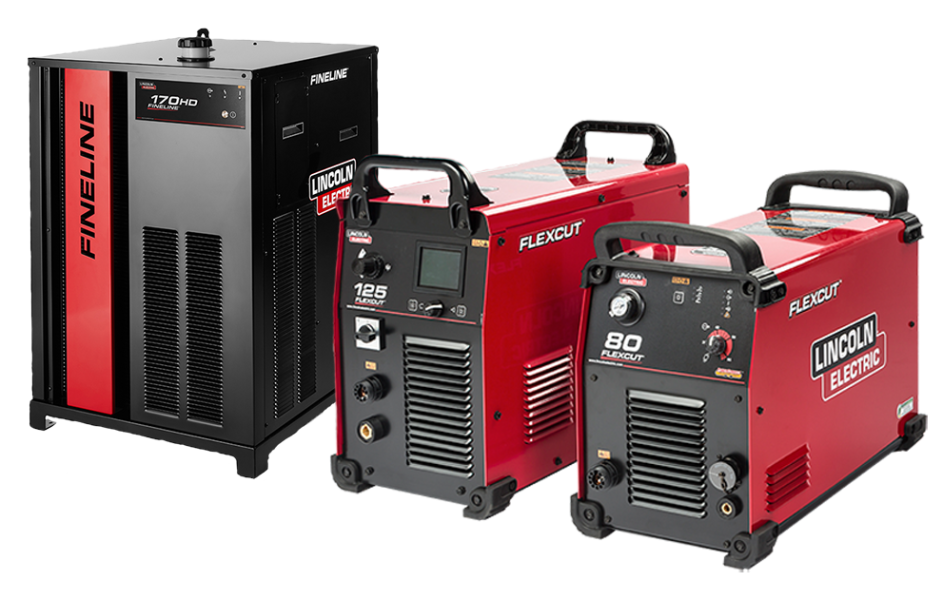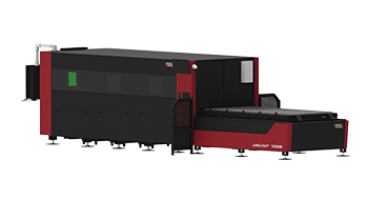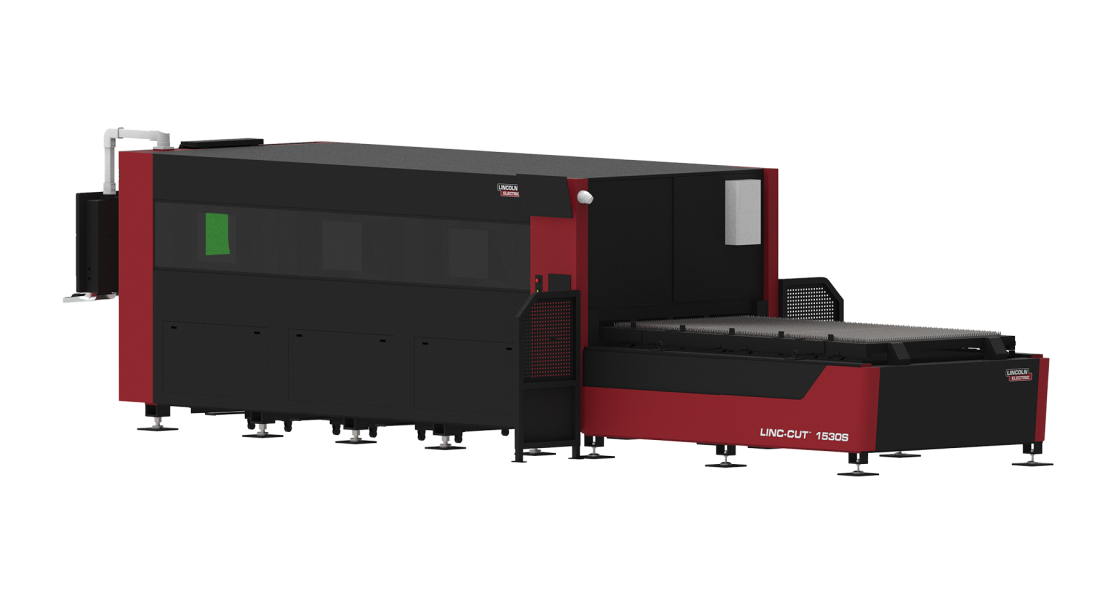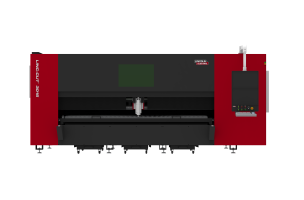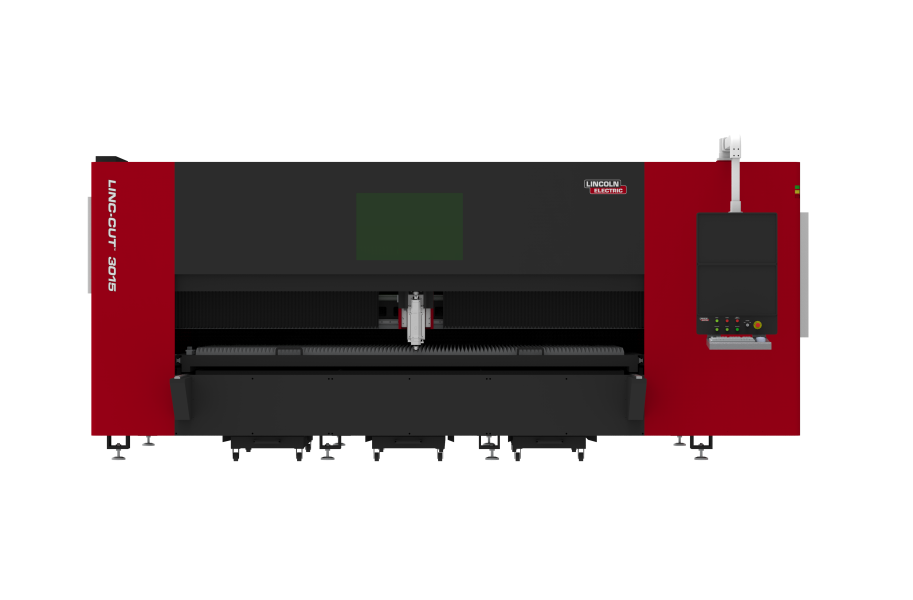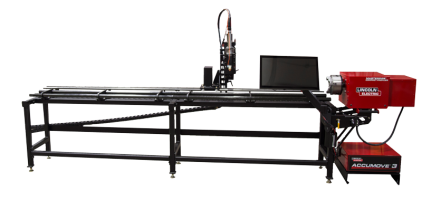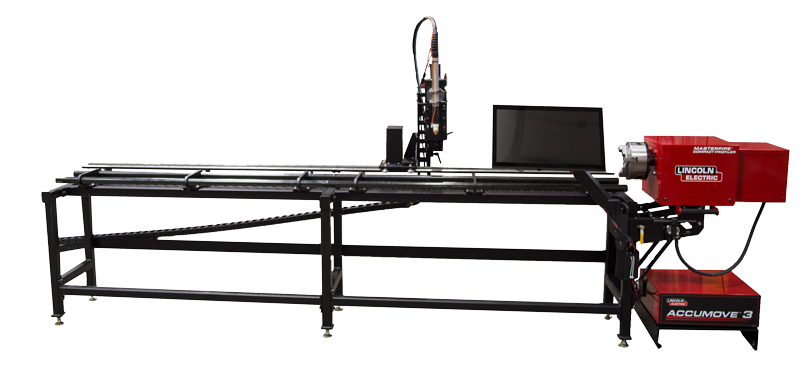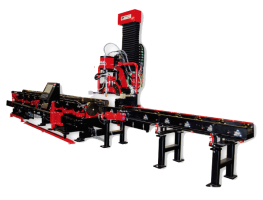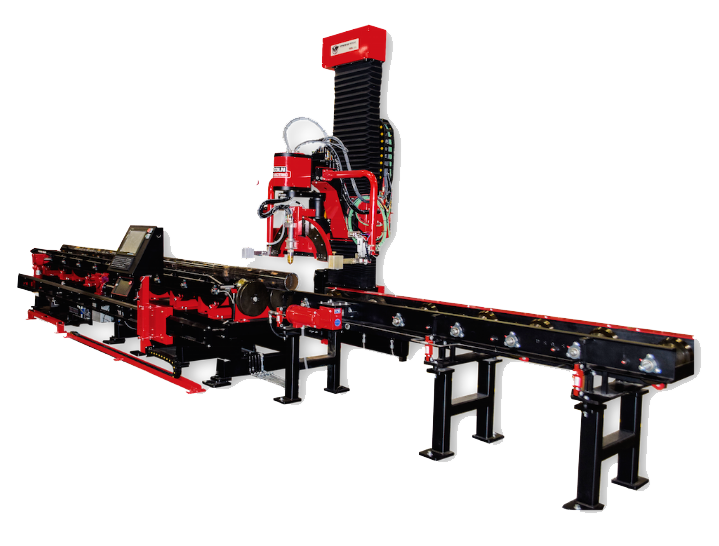Getting Started with the Red Display AVHC
Installation
It is very important the electronics connections be properly installed, as the AVHC unit will not work as it was designed to otherwise. Refer to the Adobe Acrobat file titled Electronics Connections (Located on the Torchmate Instruction CD), which shows pictures of the wiring, and has more specific instructions.
No power will be displayed until the two main wires are connected to the motor on top of the Height Control mechanical assembly.
We will begin the installation process by looking at the back side of the height control box. Start by installing the 4 pin screw-on connector to the far right side of the box. This connector has two wires coming out of the rear of the connector. The one that has a serial connector attached to it will be installed on the motor of the mechanical assembly, while the wire that has no connector on its end will be used to tie into the Raw Arc Voltage in you plasma cutter. To its left, is a 9 pin screw-on connector that has one larger cable coming out of the rear. This cable has a serial connector attached to it that will also be installed on the motor of the mechanical assembly. Be sure to tighten both of the serial ports to the motor assembly, but do not over tighten as it may break the posts. Both of these wires are essential as they provide constant communication to and from the motor. The Start Input connectors will be connected to the Machine Interface relay box, using a short length of 1 pair 18 gauge wire. The Start Output will be connected to the Start/Stop circuit from your plasma cutter. This is so the signal from the relay box will travel into the Height Control box via the Start Input, it will then measure the voltage before traveling back out through the Start Output, and into the Start/Stop circuit to fire the torch on command. You should now be able to power up the height control box, and 000 (if your unit reads a volt or two this is not a problem) should be displayed on the Liquid Crystal Display.
Setting the Pierce Height
Dialing in your pierce height is the cornerstone to successful plasma cutting. Ideally, the pierce height should be set to 3/16” off of the material surface you are cutting, to allow the plasma to penetrate. This will help maintain the height of the torch tip while the voltage is being read, and maintained.
To begin, turn on all of the Torchmate electronics (Driver box, Signal Generator). When all are powered up, open the Driver Software Program, go to the Controller menu, and select Online to establish a communication link between your PC and the Signal Generator. Now, power up your Arc Voltage Height Control unit, but leave the plasma cutter turned OFF.
Set three of the switches on the height control unit as follows: Set, Man, and Cut. Dial the small knob on the front of the height control unit so that the indicator line is pointing straight up at “High Noon”. Flip the first switch on the left to Read. Now go to your driver software’s main screen window, and toward the lower right area, click on the AUX button. AUX stands for Auxiliary, and is the manual control for turning your plasma On & Off. Once you have clicked the AUX button,
the screen will change showing you a grey colored button that displays “1- Plasma (Off)”. Click on this button once, where a precautionary window will appear alerting you that the plasma cutter is about to turn on and asking if it safe to proceed. If you are, press OK. The torch will lower to the material, sense it, and then back off to the pierce height. Since our switch is flipped to Manual, the torch will stay at the pierce height position until you press the button again to turn the torch off. Measure the distance that the torch tip now rests away from the material surface. It may be as high as 1/4” to 3/8” off the material surface. Once you have measured the gap distance, write it down, go back to the auxiliary tab and click on the yellow button (Plasma On) to open the circuit and return the torch to its normal resting height.
To adjust the height of the pierce position, flip the first switch on the left from Read to Set, dial the small knob to the left to about the “11 o’clock position”, flip the switch back to Read, and then re-test the pierce height using the method described above. Continue testing the pierce height control until the pierce height adjustment rsts at 3/16” off the material. If you find that you are as far to the left as the small adjustment knob will go, and the pierce height is still above 3/16 of an inch, contact Torchmate Tech Support for more information.
Once the pierce height is configured, it is time to adjust you dwell timing.
Setting the Dwell Timing
To set your Dwell Timing, click on the Configuration menu, and select Custom M Codes (or “M Code Definitions” on version 2.14 or later). Toward the top half of the page you will see the M Codes area. As you can see there are two fields for setting your dwell times, under the headings of M50 and M51. The delay times are shown at the right side of each column between Before and After. This is where you may change the dwell timing for your machine.
Since you are using the height control unit to maintain the arc voltage during your cutting, you will want to start your M50 dwell at 5 seconds. This will allow enough time for the torch to lower to the material, sense it, back off to the Pierce Height, fire the pilot arc, penetrate the material and reach a stable voltage before the adjustment for voltage begins. The dwell time may need to be increased or decreased depending on the type of material, the thickness of the material, the program feed rate, and amount of amperage used. If you find that you are not getting the pierce quality you are looking for, it may be necessary to adjust your dwell timing. Start at 5 seconds, and then adjust the timing +/- 0.10 seconds depending on how the cut actually performs. Continue adjusting the dwell at .10 sec intervals until you achieve your desired pierce quality.
The M51 (Plasma Off) is the amount of time after the torch turns off that it will remain idle, while the compressed air cools off the tip of the torch, before moving to the next cut. This should be set to 1.5 seconds. If your plasma cutter has a low duty cycle rating it may be necessary to increase the timing to allow your plasma cutter more time to recover between cuts.
Preliminary Test Cutting in Manual mode
With the Pierce Height and Dwell timing set, you can now utilize the manual mode of the controller to establish your arc voltage settings, by running a program with the torch on, and watching the LCD display on the Arc Height Control unit.
Open your Torchmate Cad and create two parallel lines for test cutting. Using the Node Edit tool, place one node on the material sheet.
Now place a second node approximately 6 inches away.
Copy the single line using the Array tool in the Layout Menu.
Here you have two parallel lines, export them as a dxf (Line) file to a folder on your hard drive. Import the dxf file to the driver software, and prepare the system for cutting.
When the initial cut begins, the torch will pierce the material then move along the cut path. While it is cutting, watch the LCD display for the voltage fluctuations, which will usually be somewhere between -60 to -200. Record the voltage range for each program cut in manual mode. The voltage reading, at which the torch settles and consistently runs, should be the appropriate initial setting for running the height control in Auto mode. After several Manual Mode tests have been conducted, run the same program again on fresh material. Flip the switch from Man to Auto, put the far left switch to Set, and then turn the large dial to the most consistent voltage setting that you recorded while in the manual mode. Push the switch to Read before running the program. The torch should now be able to cut your tool path without any fluctuation towards or away from the material. Be sure to record all setting adjustments you make, and the results of those changes, to help you determine if you are making steady progress towards you desired results.
Manual mode testing is essential in finding the consistent voltage that will allow the torch to stay at the necessary height above the material, and maintain it when the material rises from the resulting heat exchange during the cutting process. We recommend that you start with manual cutting whenever you are changing type, or thickness of material. It is also recommended that you consult the manufacturer’s Cut Chart for your plasma cutter, as it will help you to define the amount of amperage, air pressure, voltage, and cutting speeds to give you the best results possible.
Manufacturer Cut Charts
These charts are located in the Operators Manual. Should you not be able to locate them, please contact Torchmate Technical Support or the Customer Technical Support provided by your plasma torch manufacturer.
Begin Cutting in Auto Mode
Now that you have all the pieces of the puzzle in order (Dwell Timing, Pierce Height, Amps, PSI, and Voltage) it’s time to cut in the Auto mode. On the height control, flip the first switch from Read to Set, and the second switch from Man to Auto. Dial the large knob to the most consistent voltage reading you found and then flip the first switch to Read. Load a simple test cut program into the driver software, make sure that the torch is over new material, zero out the program coordinates, attach the work clamp to the material, check the air compressor to be sure that it is on and fully charged, and then turn on your plasma cutter.
When ready, press the Start button to begin the cutting program. Stay close to your computer, and to the height control box, just in case the torch moves too close to the material, so that you can Stop the program if necessary.
Was your object cut cleanly? Did it fall away from the material sheet? After the program has stopped, let the fallen piece cool, and then pick it up with a pair of pliers or other utensil so that you can inspect the cut quality.
Troubleshooting
In the event that you are not achieving your desired results, please review these topics, and try as many adjustments as necessary to regain your cut quality.
Arc Voltage Errors
If the torch is diving into the material it could be that the arc voltage is set too low. The torch will automatically search for the voltage it has been set to maintain, thus it will look for it in the material or closer to the power source to maintain its voltage level. To correct this, increase the voltage setting 1 to 2 volts higher for starters, and continue to raise it if necessary.
If the Arc Voltage is set too high, the arc may actually spike up and stay further way from the material than normal, or may step upward, and will lose the arc altogether. The initial arc will penetrate the metal but it may not be able to maintain this high of a voltage setting, thus the AVHC inevitably moves too high off the material and the arc is lost and will rise to the top of its travel. To correct this, a decrease the voltage setting 1 to 2 volts lower to start, and continue to lower if necessary.
Make sure that the Raw Arc Voltage take-off wires are connected to the DC+ and DC – terminals inside your plasma cutter
If the Torch moves toward the material, touches it, then backs off, fires, pierces, then backs off in steps, loses arc but continues to follow program, check the fuse located on the left side panel of the height control unit. Push in on the small retaining cover with a small flathead screw driver, and turn to the left to release the fuse. This fuse is a 1 amp, 250 volt, slow-blow fuse, and can be found at Radioshack (part # 270-1063) or other electronics retailers. You can use up to a 5 amp fuse if the 1 amp fuse continues to blow. If the torch does not fire then check the fuse in the machine interface.
Check the Consumables
In the torch head the electrode must move up and down freely for the torch to fire. The plasma unit looks for continuity between the electrode tip and nozzle before the torch will turn on the air and initiate the arc. The air forces the electrode up away from the nozzle to make electrical contact with another contact point in torch body permitting current flow to the electrode.
If there is slag or foreign matter keeping the electrode from making electrical contact with the nozzle when the air is off the plasma unit will alarm and not fire. The alarm will reset after 10 seconds. If the electrode cannot slide up freely and make electrical contact after the air is turned on, the torch will fire with a lowered amperage, or misfire completely.
The Retaining cap for the consumables and swirl ring should only be finger tight, if the cap is over tightened the electrode may not move freely enough to function properly.
Check the Compressor
The air pressure fed into your plasma cutter must be in the range of 90 to 120 psi in order to consistently create plasma in a given range of 65 to 90 psi. If you are using a compressor to supply air to more than one line at a time, be sure that it can maintain a level of pressure to allow all lines to consistently supplied, otherwise your tank may be draining faster than the compressor can recharge the holding tank. Consider switching to a dedicated tank for you plasma operation.
In the process of creating compressed air, water condensation collects in your holding tank. This condensation can also leak into the line supplying air to your plasma cutter. In most plasma torch systems, a water separator valve is utilized to allow the collection and drainage of excess condensation passing through the air line. Even with this preventive measure, condensation can still bleed into the torch line itself, and cause misfiring, or total system failures. To ensure that the excess condensation is removed, drain your holding tanks and water separator often, or whenever condensation is present. This will help to prevent Ignition failures.
The Work Clamp
The work clamp, or ground wire, should always be attached to the material that you are cutting. This will ensure that the electricity needed to cut through the material is flowing from the Torch tip (Negative charge) to the work clamp (Positive charge) in a path of least resistance. Attaching the work clamp to the table can cause this electricity to flow through other components of the table, such as the motors, and cause internal damage.
Check the Fuses
If the air comes on prior to a torch ignition, but the torch does not fire, check to see if there are any warning lights flashing or continuously lit which are displaying a malfunction on your plasma unit. If so, check your plasma unit’s manual for troubleshooting help, or call the Technical Support of the manufacturer for preventive and/or corrective measures.
Routine Maintenance
The performance of the height control will decrease the longer you wait between routine maintenances. The consumable smoke and dust will coat the machine screw, linear slide bearings, and motor assembly over prolonged use. Here are two simple tasks you can perform to keep your Height Control in great shape.
1. Whenever possible remove the consumable dust from the mechanical assembly of the height control. This works best with a compressed air nozzle.
2. Lubricate you linear slide bearings with 3 in 1 oil, and then jog the height control up and down for one minute. Do not use WD-40, as it will remove the grease from the machine screw.



